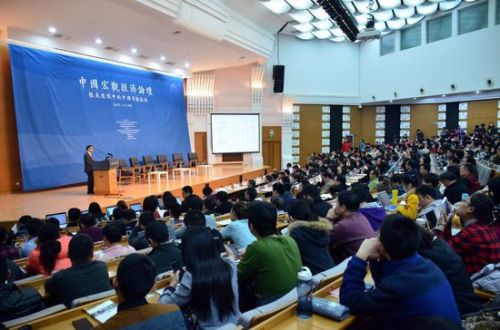Report predicts stable medium-to-high growth

The Annual Report on Analysis and Forecast of China’s Macroeconomy (2015-2016) was released by Renmin University of China on Nov. 22 in Beijing.
China’s macroeconomic indicators are set to rebound steadily in the latter half of 2017 and gradually get on track to stable medium-to-high growth, according to a new report released by Renmin University of China on Nov. 22 in Beijing.
The Annual Report on Analysis and Forecast of China’s Macroeconomy (2015-2016) revealed that many emerging industries, modes of operation and driving forces have laid the foundation for the next round of medium-to-high growth.
An established market force has accelerated China’s economic restructuring, according to the report.
Liu Yuanchun, executive director of the National Academy of Development and Strategy at Renmin University, stressed the need to be soberly aware that strategic emerging industries account for only 8 percent of China’s GDP, despite the hope brought by new factors driving economic development.
It takes a long time to foster an industry, but from a long-term perspective, strategic emerging industries will play a huge role in driving China’s economy, Liu said.
“'Internet Plus' is an emerging industry in China’s economic system,” said Cao Heping, a professor from the School of Economics at Peking University.
The rise of emerging industry clusters indicates that restructuring has been partly realized in the real economy. The new economic structure is what supply-side management is all about, Cao said.
Cao added that supply means to enhance economic development potential, and in terms of economic transformation, it is important to soak up excess capacity and deflate bubbles while recycling economic factors withdrawn from original industries.
According to the report, macroeconomic indicators will continue to slip due to the combined effect of the world economic cycle, real estate booms and busts, debt, and industry cultivation in China, as well as macroeconomic policy repositioning. In addition, China’s economy will begin to stabilize as economic restructuring progresses, new mechanisms for driving economic growth are constructed and the external environment improves.
This will present opportunities for substantial stock adjustments, overhaul of supply-side management model and larger-scale demand-based expansion, paving the way for the reversal of the economic cycle and the normalization of medium-to-high growth in 2017, according to the report.
Scholars said that supply-side management reform is a long-term process, but demand-side adjustment is a short-term task. During the adjustment of supply-side management, negligence of demand-side adaptability is not allowed, they said.
Wang Yiming, deputy director of the Development Research Center of the State Council, said attention should be paid to the inability of supply-side measures to adapt to changing market demands. Meanwhile, new driving forces need to develop gradually to fill the gap caused by the decline of traditional sectors.
“Economic slowdown has brought an opportunity for economic restructuring and impetus switching. We must seize it to speed up structural adjustment, end overcapacity, reorganize intellectual property, strengthen the market’s resource allocation function, revitalize the substantive economy and stimulate internal vigor,” Wang said.
On the current economic situation, Hu Naiwu, a senior professor at Renmin University, said that the transition of the Chinese economy from high to medium-to-high growth conforms to the evolutionary rule of the three industries, observes the law of economic development and suits the actual conditions of China.
According to the evolutionary rule of the three industries, China is progressing from an industrial society to a service one. The faltering labor productivity of the service industry is bound to impact economic growth, Hu said.
When it comes to the next stage of macroeconomic development, scholars said that the internationalization of the RMB, risk management, and standardized management of government revenue and expenditure budgeting will be focal points of China’s macroeconomic development in 2016.
“We should recognize what a serious situation China’s economy is in while holding fast to the bottom line of macroeconomic policies for the next five years,” said Gao Peiyong, CASS Member of the Chinese Academy of Social Sciences (CASS) and director of the National Academy of Economic Strategy under CASS.
First, according to the basic goals proposed at the Fifth Plenary Session of the 18th CPC Central Committee, China’s GDP will reach 82 trillion yuan by 2020, per capita urban disposable income should reach 38,000 yuan and per capita rural disposable income should reach 11,800 yuan. This is the focus of research on China’s macroeconomic policies for the next five years, Gao said.
Second, different patterns of thinking are required to weigh China’s macroeconomic policy layout for the next five years. “We must build consensus to consider policy measures with goals in mind. We must promote reform in the countdown manner. We must reverse accounts to make clear the expansive effects needed for each year of the next five-year period,” Gao said.

 PRINT
PRINT CLOSE
CLOSE